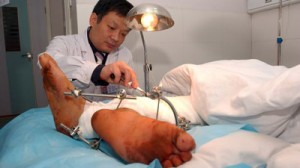How to innovate: Sony camcorder with projector
The full list of outcomes for video is:
- Recording
- Storing
- Editing
- Locating / Selecting
- Viewing
- Disposing
Doing each of those anywhere, anytime, for whoever, for the price desired with no hassle is the ultimate.
Including a projector on the camcorder satisfied an outcome that was under-satisfied. It also utilized existing components so the extra feature was less cost than an extra device.
Future innovations will be in editing, and selected sharing. As I’ve mentioned in other posts augmented or diminished reality could be useful in a camcorder.
Women's fashion innovation hides camel toe
Camel toes occurs when a woman’s pants are too tight the fabric rides up expose the shape of her intimate area. Smooth Groove prevents the embarrassing effect.
This product follows in a long line of women’s undergarments that strategically reveal or conceal some portion of the figure. The obvious solution for camel toe is to not wear pants that are so tight they leave nothing to the imagination. The goal of such tight pants is to leave a select bit to the imagination, and thus the opportunity for Smooth Groove. The maker put a lot of thought into the design of the product and the image for the product.
Now that Smooth Grove is available to prevent displaying camel toe expect another product that artificially creates it. Wearing pants that are tight enough to expose the shape underneath is uncomfortable. It would be much more comfortable and potentially esthetically pleasing to wear a “New Groove”.
Doctors save left foot by attaching it to right leg
Doctors in China use many principles of Predictive Innovation® to save a man’s foot when it was cut off in an accident.
http://web.orange.co.uk/article/quirkies/Doctors_put_left_foot_on_right_leg
The man’s foot was cut off because of an accident. The damage to the leg prevented the foot from being immediately reattached. So there was a dilemma.
Must re-attach the foot to the leg immediately so it doesn’t die; but, we can’t attach the foot until the leg heals and grows.
One way to handle dilemmas is to invert then rephrase. Instead of immediately reattaching the foot to the same leg they attached it to the other leg. This was a great idea because the patient would not be able to walk while the other leg was growing and healing after moving it to the correct leg. Attaching the foot to the patients other leg is the perfect environment for the foot while waiting.
Other approaches have been tried such as freezing the organ to be reattached. Current technology can’t reliably prevent damage from ice crystals.
Another improvement could be using stem cells cultured from the patient and sprayed onto a growth matrix. This could accelerate the grow and the healing when the foot is reattached.
Another inversion is to let the foot die and attach a cloned foot. That technology has already been used for less complicated body parts.




 Predictive Innovation Training
Predictive Innovation Training Predictive Innovation: Core Skills Book
Predictive Innovation: Core Skills Book RoundSquareTriangle.com
RoundSquareTriangle.com